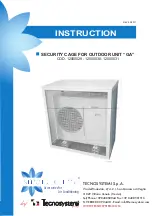
Manual 2100-752C
Page
27 of 41
found on page 37. It is imperative to match the correct
pressure table to the unit by model number.
This unit employs high-flow Coremax valves instead of
the typical Shrader type valves.
WARNING! Do NOT use a Schrader valve core removal
tool with these valves. Use of such a tool could result
in eye injuries or refrigerant burns!
To change a Coremax valve without first removing the
refrigerant, a special tool is required which can be
obtained at www.fastestinc.com/en/SCCA07H. See the
replacement parts manual for replacement core part
numbers.
Important Installer Notes
For improved start up performance, wash the indoor
coil with a dishwashing detergent.
Dehumidification Models
Exposure to high pressure refrigerant hazard.
Dehumidification models are equipped with an
electronic expansion valve (EEV). In order to fully
recover refrigerant or evacuate system during repairs,
either use service tool P/N 2151-021 to manually open
the EEV or be sure to recover and evacuate from all
service ports: suction, liquid and discharge.
Failure to do so could result in eye injuries and/or
refrigerant burns.
Service Hints
1. Caution owner/operator to maintain clean air filters
at all times and also not to needlessly close off
supply and return air registers. This reduces airflow
through the system, which shortens equipment
service life as well as increasing operating costs.
2. Check all power fuses or circuit breakers to be sure
they are the correct rating.
3. Periodic cleaning of the outdoor coil to permit full
and unrestricted airflow circulation is essential
.
High and Low Pressure Switches
All Q**A4 series models are supplied with high and low
pressure switches that reset automatically in response
to system pressures. High pressure switch settings:
Opens 650 +/– 15 PSI, closes 520 +/– 15 PSI. Low
pressure switch settings: Opens 40 +/– 4 PSI, closes
55 +/– 5 PSI.
Pressure Switch Lockout
The high and low pressure switches are included in
a lockout circuit that is re-settable from the room. In
the event of a high or low pressure switch lockout, a
visual indication can be seen from the compressor logic
control board. See
Troubleshooting Compressor Logic
CCM
on page 28 for further explanation.
Three Phase Scroll Compresser Start
Up Information
Scroll compressors, like several other types of
compressors, will only compress in one rotational
direction. Direction of rotation is not an issue with
single phase compressors since they will always start
and run in the proper direction.
However, three phase compressors will rotate in either
direction depending upon phasing of the power. Since
there is a 50-50 chance of connecting power in such
a way as to cause rotation in the reverse direction,
verification of proper rotation must be made. A phase
rotation meter can be used to verify a clockwise
phase is being supplied. Verification of proper rotation
direction can also be made by observing that suction
pressure drops and discharge pressure rises when
the compressor is energized. Reverse rotation also
results in an elevated sound level over that with correct
rotation, as well as substantially reduced current draw
compared to tabulated values.
Verification of
proper rotation
must be made at the time
the equipment is put into service. If improper rotation
is corrected at this time, there will be no negative
impact on the durability of the compressor. However,
reverse operation for over 1 hour may have a negative
impact on the bearing due to oil pump out.
NOTE:
If compressor is allowed to run in reverse
rotation for an extended period of time, the
compressor’s internal protector will trip.
All three phase compressors are wired identically
internally. As a result, once the correct phasing is
determined for a specific system or installation,
connecting properly phased power leads to the same
Fusite terminal should maintain proper rotation
direction.
The direction of rotation of the compressor may be
changed by reversing any two line connections to the
unit.
Compressor Control Module
When the green status light blinks, this indicates that 24
volt power is applied to the board and the controller is
running in normal operation (see Figure 23 on page 28).
On initial power up and call for compressor, a 5-minute
delay plus a random start delay of 0 to 60 seconds is
applied. After the random delay, the compressor relay is
energized (terminal CC). When the Y1 input opens, the
compressor de-energizes.
The compressor control module (CCM) is standard on
all models covered by this manual. It is an anti-short
cycle/lockout timer with high pressure, low pressure
and freeze stat switch monitoring and alarm output.
After compressor shutdown, or power disruption,
a 5-minute timer is applied which prevents the
compressor from operating.
Summary of Contents for Q-TEC Q A4D Series
Page 2: ......
Page 24: ......
Page 65: ...Manual 2100 752C Page 41 of 41 GRAPH 3 Q48A4D FAD Ventilation Delivery ...
Page 66: ......
Page 81: ...Manual 2110 1568G Page 15 of 17 This page intentionally left blank ...
Page 84: ......
Page 95: ......
















































